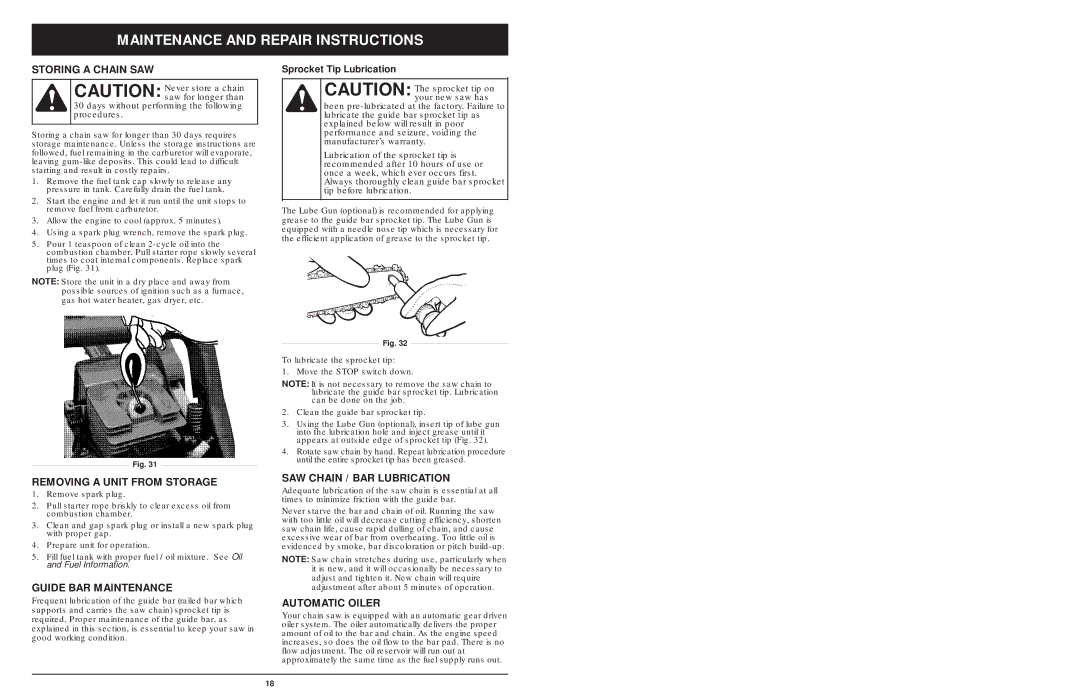
MAINTENANCE AND REPAIR INSTRUCTIONS
STORING A CHAIN SAW
CAUTION: Never store a chain saw for longer than
30 days without performing the following procedures.
Storing a chain saw for longer than 30 days requires storage maintenance. Unless the storage instructions are followed, fuel remaining in the carburetor will evaporate, leaving
1.Remove the fuel tank cap slowly to release any pressure in tank. Carefully drain the fuel tank.
2.Start the engine and let it run until the unit stops to remove fuel from carburetor.
3.Allow the engine to cool (approx. 5 minutes).
4.Using a spark plug wrench, remove the spark plug.
5.Pour 1 teaspoon of clean
NOTE: Store the unit in a dry place and away from possible sources of ignition such as a furnace, gas hot water heater, gas dryer, etc.
Fig. 31
REMOVING A UNIT FROM STORAGE
1.Remove spark plug.
2.Pull starter rope briskly to clear excess oil from combustion chamber.
3.Clean and gap spark plug or install a new spark plug with proper gap.
4.Prepare unit for operation.
5.Fill fuel tank with proper fuel / oil mixture. See Oil and Fuel Information.
GUIDE BAR MAINTENANCE
Frequent lubrication of the guide bar (railed bar which supports and carries the saw chain) sprocket tip is required. Proper maintenance of the guide bar, as explained in this section, is essential to keep your saw in good working condition.
Sprocket Tip Lubrication
CAUTION: The sprocket tip on your new saw has
been
Lubrication of the sprocket tip is recommended after 10 hours of use or once a week, which ever occurs first. Always thoroughly clean guide bar sprocket tip before lubrication.
The Lube Gun (optional) is recommended for applying grease to the guide bar sprocket tip. The Lube Gun is equipped with a needle nose tip which is necessary for the efficient application of grease to the sprocket tip.
Fig. 32
To lubricate the sprocket tip:
1. Move the STOP switch down.
NOTE: It is not necessary to remove the saw chain to lubricate the guide bar sprocket tip. Lubrication can be done on the job.
2.Clean the guide bar sprocket tip.
3.Using the Lube Gun (optional), insert tip of lube gun into the lubrication hole and inject grease until it appears at outside edge of sprocket tip (Fig. 32).
4.Rotate saw chain by hand. Repeat lubrication procedure until the entire sprocket tip has been greased.
SAW CHAIN / BAR LUBRICATION
Adequate lubrication of the saw chain is essential at all times to minimize friction with the guide bar.
Never starve the bar and chain of oil. Running the saw with too little oil will decrease cutting efficiency, shorten saw chain life, cause rapid dulling of chain, and cause excessive wear of bar from overheating. Too little oil is evidenced by smoke, bar discoloration or pitch
NOTE: Saw chain stretches during use, particularly when it is new, and it will occasionally be necessary to adjust and tighten it. New chain will require adjustment after about 5 minutes of operation.
AUTOMATIC OILER
Your chain saw is equipped with an automatic gear driven oiler system. The oiler automatically delivers the proper amount of oil to the bar and chain. As the engine speed increases, so does the oil flow to the bar pad. There is no flow adjustment. The oil reservoir will run out at approximately the same time as the fuel supply runs out.
18
